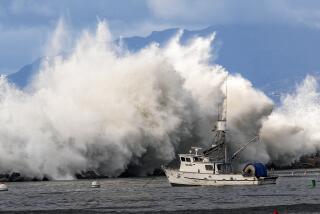El Niño more like Los Niños, weather study finds
El Nino, the seasonal Pacific Ocean warming that affects the world’s weather, may not be just one little boy -- it seems to be two little boys.
Two distinct patterns of warming occur in the Pacific Ocean, according to researchers at the Georgia Institute of Technology in Atlanta, and their frequencies have been changing in recent decades.
Tracking one of these two events could yield earlier, more-accurate predictions of North Atlantic hurricanes.
The periodic warming (El Nino) and cooling (La Nina) of the eastern equatorial Pacific Ocean is known as the El Nino Southern Oscillation and affects global weather patterns.
El Nino, which occurs about every three to five years, is an ocean warming that begins in the early summer months and reaches its peak in December.
The event can bring droughts to Australia, flooding in the Southern U.S. and Peru, changes in the Indian summer monsoon, and fewer North Atlantic hurricanes.
But after poring over more than half a century’s worth of atmospheric and oceanic data collected by national and international centers, the Georgia Tech researchers concluded that there are in fact two forms of Pacific Ocean warming, and that these have different effects on the frequency and paths of North Atlantic hurricanes.
One form, eastern Pacific warming, correlates with hurricane activity identical to that of the conventional El Nino.
The other form, central Pacific warming, is associated with enhanced hurricane activity on the Eastern Seaboard of the U.S. and eastern Mexico.
“Apparently, El Nino comes in two flavors,” said Kerry Emanuel, an MIT atmospheric science professor who was not involved in the study. Knowing that these two independent modes have different effects could factor into Atlantic hurricane predictions, he added.
By tracking the second pattern, instead of just focusing on El Nino as a whole, “we may know what the character of the hurricane family in the next season will look like,” said report coauthor Peter J. Webster, professor of Earth and atmospheric sciences at Georgia Tech.
North Atlantic hurricanes can cause billions of dollars in damage in the U.S. alone.
Hurricane forecasting efforts now use El Nino as a whole to predict the number and frequency of hurricanes that will occur in the summer and fall. But these predictions cannot be made before June.
“In May, the Pacific Ocean is trying to decide whether to have an El Nino, a La Nina, or remain neutral,” Webster said.
The study’s findings, published Friday in the journal Science, could help provide a few extra months of lead time. That’s because the central Pacific warming starts its annual cycle slightly earlier than the eastern pattern. This would help the insurance industry, which now must lock in its annual rates before the Pacific activities become clear.
The scientists also found that the central Pacific warming events have increased in frequency over the last few decades: 80% of them in the last 60 years have occurred since 1990. At the same time, the eastern Pacific warming events have declined.
Nobody knows why, Webster said. It could be temporary, associated with natural oceanic or atmospheric oscillations, he added. But it is also possible that increasing sea surface temperatures associated with global warming may be causing the shift by triggering changes in trade-wind patterns.
“The nature of El Nino is changing, and there are lots of subtleties,” Webster said. “We want to predict those variations in El Nino and work out what the implications are of this new type of Pacific Ocean warming.”
--






